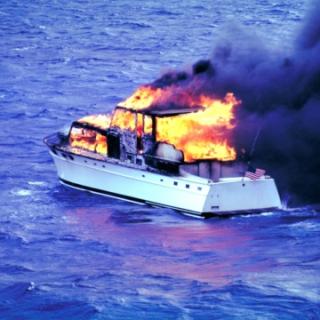Fire
A fire aboard a vessel is very scary. With an uncontrolled blaze, there is nowhere to go except into the water or a life raft. A boat fire spreads very rapidly. You must attack it immediately and effectively; otherwise you will deplete your extinguishing resources before you put it out.

Fire management is especially important on wood and fiberglass boats, as fires aboard these vessels can double in size every 10 seconds. A fire extinguisher only lasts 10-15 seconds. Aim it at the base of the fire, and sweep back and forth.
Approximately 7,500 pleasure boat fires and explosions occur annually; of those affected, 10% are declared total losses.
To effectively extinguish a fire, remember the acronym FIRE,
Find the fire – pinpoint its source and determine its size.
Inform the skipper and crew immediately
Restrict the fire; disable the cause of the fire; de-energize electrical systems in affected space; shut off fuel supply and ventilation.
Extinguish the fire
Fires are divided into four classes, depending on the fuel that is feeding them. Each class requires a different chemical to extinguish it.
- Class A – paper, wood, fabric, fiberglass – Extinguish with water, tri-class powder, CO2.
- Class B – fuel, oil, resin, paint – Extinguish with tri-class powder, CO2, Halon replacements
- Class C – electrical short igniting wires – Break the circuit, turn off main switch, extinguish fire
- Class D – Burning metals, like flares – Get the source off the boat.
Common causes of fire on boats
- Poorly installed electrical systems
- Engine and transmission overheating
- Gasoline fuel leak and a spark
- Poor installation of propane system
Fire Management Tips
- Crew action: As soon as a fire is detected the crew should be prepared to abandon ship with no delay.
- Boat design: Is there any place on the boat - say in an engine compartment or galley by the companionway - where a fire could block exit by the crew?
- Helmsman: should point the boat to fan the fire in a direction most advantageous for the crew (eg downwind so the fire goes away from the cockpit if abandoning ship)
- Install automatic discharging extinguishers in engine compartment
- Mount approved ABC fire extinguishers throughout the boat
- Install an electronic gas detector in the bilge
- After cooking, switch off the solenoid, then let the burner continue to flame until the line is clear of gas, then turn off the burner.
Safety Moment – John Jourdane with thanks to Chuck Hawley and Michael Jacobs






